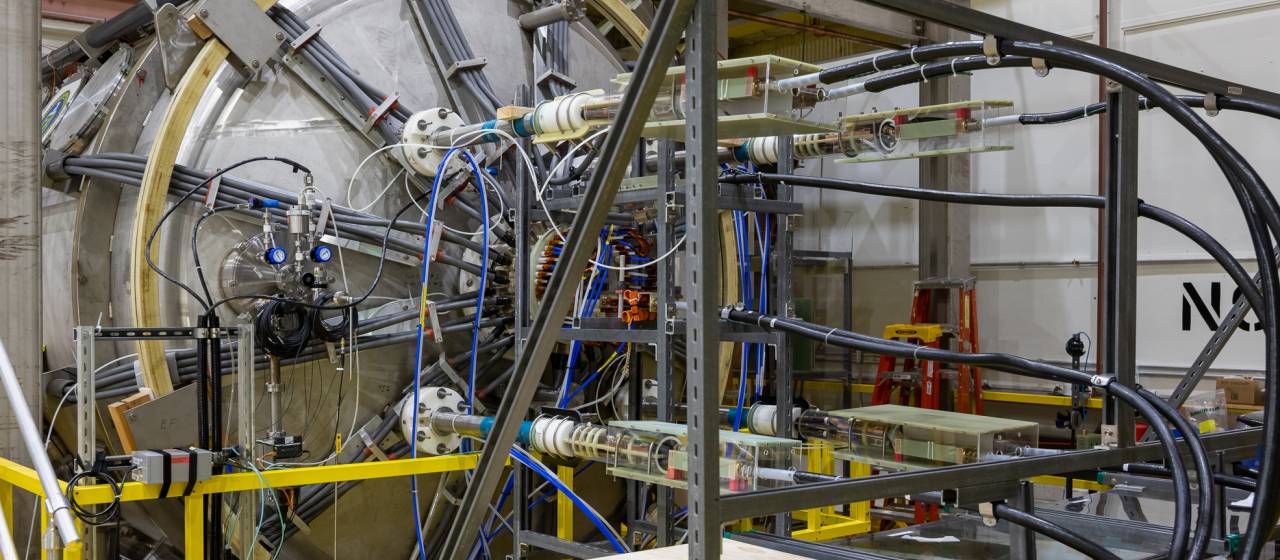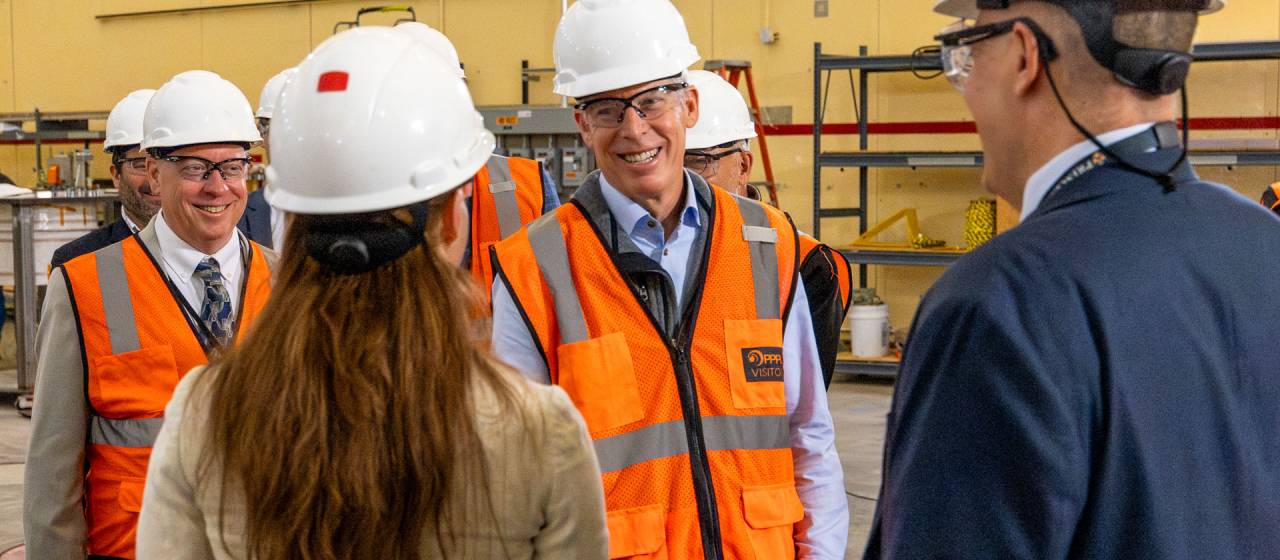Unprecedented new device at PPPL will help unravel mysteries of the universe
In a spacious room with towering ceilings, a gleaming device resembling a metal barrel the size of an SUV lies on its side, ready to perform some science.
Known as the Facility for Laboratory Reconnection Experiments (FLARE), the machine represents the next generation of research into fundamental plasma physics at the U.S. Department of Energy’s (DOE) Princeton Plasma Physics Laboratory (PPPL). At 12 feet long, 9 feet in diameter and weighing more than 10 tons, FLARE is a first-of-a-kind, world-class facility.
On June 12, the Laboratory celebrated the beginning of operations for FLARE with a private ribbon-cutting event. More than 50 people gathered, including officials from DOE, Princeton University and PPPL.
“This is the day when we deliver FLARE to the world,” said PPPL Director Steve Cowley. “We have fulfilled our promise to design and build this one-of-a-kind device and offer it to the scientific community. I expect FLARE to produce important insights for plasma science in the coming years, and I just can’t wait.”

Dignitaries formally inaugurate the beginning of FLARE operations. From left: Vyacheslav (Slava) Lukin; Hantao Ji, PPPL physicist and FLARE’s principal investigator; Brandon Thorne, director of Princeton University’s Office of the Vice President for PPPL; Jennifer Rexford, provost of Princeton University; Steve Cowley, PPPL director; Christian Newton, chief of staff at the DOE’s Office of Science; J.P. Allain, associate director of Fusion Energy Sciences for the DOE’s Office of Science; Michael Ford, PPPL associate laboratory director for engineering.
FLARE allows researchers to study magnetic reconnection, a phenomenon that occurs when magnetic field lines snap apart and join together again, releasing enormous amounts of energy. Reconnection occurs throughout the universe and powers giant plasma eruptions on the sun’s surface known as solar flares.
These eruptions can generate strong winds of electrically charged particles that stream into the solar system. They can also strike Earth’s outer atmosphere, damaging communications satellites, global positioning systems and electrical grids, potentially leading to blackouts and internet outages. Moreover, reconnection occurs inside doughnut-shaped fusion devices known as tokamaks, disrupting the crucial fusion reactions and interfering with operations.
Understanding exactly how reconnection causes solar flares and tokamak disruptions can help reduce damage caused to communications networks and enhance the stability of tokamak operations. This research demonstrates PPPL’s expertise in astrophysical and fusion plasma studies.
“FLARE is a new research platform with capabilities that scientists have not had access to before,” said Hantao Ji, a professor of astrophysical sciences at Princeton University, a distinguished research fellow at PPPL and FLARE’s principal investigator. “It will provide information about magnetic reconnection that spacecraft, computer simulations and other laboratory experiments cannot provide. It’s a new way of doing research that goes beyond what is currently available.”
FLARE is designed to test a hypothesis about magnetic reconnection that could enhance our knowledge of this fundamental phenomenon. Reconnection occurs when magnetic field lines – the imaginary paths along which the effects of magnetism flow — approach one another, then suddenly break apart and reattach in new configurations. This process is enormously powerful; when it occurs on the sun’s surface and other stars, it can release the amount of energy in trillions of tons of TNT.
Christian Newton, chief of staff at the DOE’s Office of Science, said FLARE demonstrates that the national laboratory system strengthens America’s national research efforts and provides a significant competitive edge. “By investing in long-term scientific research, the national laboratories produce results that can bolster the rest of America’s science and technology sectors,” he said.
Jean Paul Allain, the DOE’s associate director for Fusion Energy Sciences, also stressed the unique capabilities and contributions of national laboratories. “Labs like PPPL can take big risks to build infrastructure that answers big questions,” he said. “FLARE is a perfect example.
FLARE's mission goal
Until now, scientists have only observed reconnection happening at one location, known as an X point, along the boundary when two magnetic field lines meet. FLARE will answer the question of whether reconnection can occur at multiple X points simultaneously by replicating more closely conditions as they actually occur in outer space.
FLARE will also help scientists understand more thoroughly how reconnection heats the plasma around it, including exactly how much energy goes into heating and how fast that heating occurs. By demonstrating multi-X-point reconnection, scientists will broaden their understanding of reconnection as it occurs in nature.
“That’s FLARE’s mission goal,” said Jongsoo Yoo, deputy head of discovery plasma science, a PPPL principal research physicist and a member of the FLARE team. “We believe that in large astrophysical systems, reconnection occurs at a large number of locations at once, but because of limitations in research space and available energy, we haven’t been able to conduct experiments to observe what happens. So far, there hasn’t been any hard evidence either way. We’re going to change that. We believe FLARE will be the first device to show experimentally that reconnection can occur at many X points.”

Solar flares on the sun's surface are eruptions of plasma. FLARE will help scientists understand them better and also enhance the stability of tokamak operations.
Exploring the universe from a lab
But how can a large metal barrel mimic huge expanses measuring light years across? The answer depends on comparison — how the size of the reconnection events compares to the overall size of the space inside FLARE.
By squashing the circular motion of charged particles such as electrons around magnetic field lines, FLARE’s magnets shrink the size of a current of electricity flowing through the plasma. And because reconnection depends on the properties of electrical currents, the reconnection sites in FLARE are relatively small.
That shrinkage matters because scientists want to create reconnection sites that are small compared to the empty space around them, just as in outer space.
This technique resembles what engineers would do if they wanted to learn whether an airplane can fly safely in a thunderstorm. They could either fly a real airplane in a storm or put a foot-long model in a wind tunnel. FLARE represents the second approach.
To help scientists achieve their research goals, FLARE can store and unleash a prodigious amount of energy. During an experiment, FLARE can discharge more than 6 million joules, the same amount of energy that could power around 1,000 houses for five seconds.
This dramatic pulse of power allows FLARE to produce the conditions needed to simulate reconnection accurately. “That’s why FLARE’s engineering is complex,” Yoo said. “You’re dealing with a lot of energy!”
FLARE’s capabilities allow it to gather information that even spacecraft cannot provide. Because FLARE is in a laboratory, scientists can use probes to measure the reconnection events directly.
In addition, spacecraft missions intended to study reconnection in space, like NASA’s Magnetospheric Multiscale Mission, involve a limited number of spacecraft, meaning that scientists can measure only a very small section of space. In contrast, FLARE allows scientists to take as many measurements as they want and get a more comprehensive picture of what’s occurring.
FLARE also beats high-powered computer simulations in terms of accuracy. “Simulations aren’t real,” said Ji. “Instead, they are trying to be real. They incorporate a lot of approximations, but because there are so many, lots of important physics is lost. And we don’t know whether the lost physics is important.”
An international hub of scientific discovery
FLARE is what is known as a collaborative research facility. This designation means that scientists from around the world can submit a research proposal and work with PPPL scientists to determine the scope of the experiment and foster long-term collaborations.
For instance, scientists could partner with PPPL scientists to develop new diagnostics, or sensors, to measure plasma properties in FLARE. “That’s our hope,” Yoo said. “We want to work with experts around the world. Unlike with user facilities, when you submit a proposal, receive a limited amount of research time, and staff scientists perform the experiment for you and give you the data afterward, FLARE focuses more on collaboration than run time. As a result, researchers can be much more hands-on with our facility.”
The opening of FLARE is a significant step toward understanding the complicated physics happening in outer space, on the surface of stars and in devices built to study and harness fusion energy. “FLARE matters to PPPL and the world because it’s important for both astrophysical and fusion plasma studies,” Ji said. “This next-generation machine confirms that we are both a national and international leader in this research.”
FLARE assembly was completed through funding from DOE under contract number DE-AC02-09CH11466 and Princeton University. The initial FLARE instrument construction was funded by the National Science Foundation Major Research Instrument grant PHY-1337831 and Princeton University, as well as contributions from the University of Wisconsin-Madison and the University of Maryland.

Scientists monitor operations in FLARE’s control room.
















